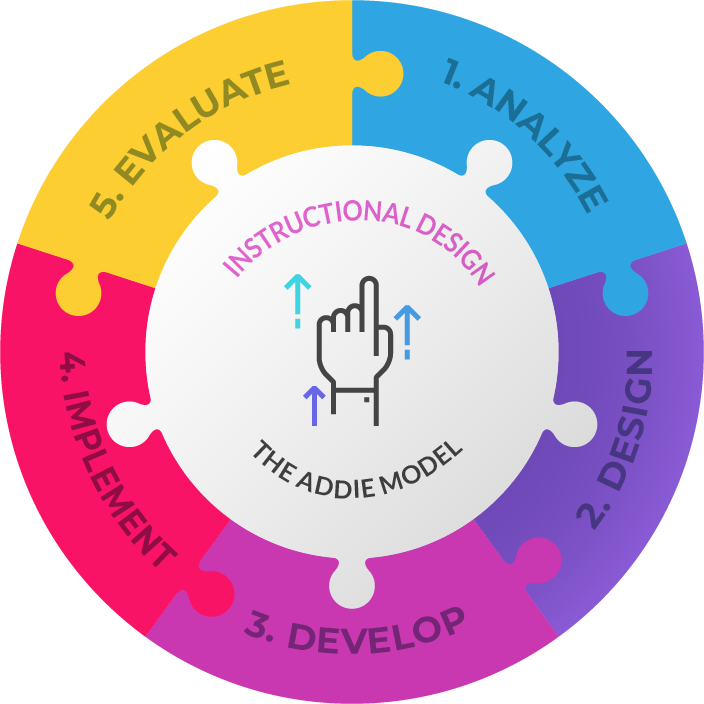In ons vorige blog hebben we het concept van Instructional Design geïntroduceerd. Nu vertellen we je graag meer over het maken van effectieve e-learning programma’s aan de hand van een model: het ADDIE model. Dit model heeft de tand des tijds doorstaan en is een van de meest gebruikte modellen door Instructional Designers. Het acroniem ADDIE bestaat uit de woorden Analyse, Design, Develop, Implementer en Evaluate. De stappen in het model zijn niet strikt lineair. Ze worden interactief en dynamisch gebruikt.
Bekijk hier de interactive versie van het ADDIE model in LesLinq.
Analyse
In de eerste stap van het ADDIE model begin je met het verdiepen in je doelgroep. Hiermee ben je er zeker van bent dat de inhoud effectief aansluit op hun behoeften, voorkeuren, kennisniveau en vaardigheden. Alle essentiële informatie die je in de content wilt integreren, ga je filteren en aanpassen aan de doelgroep. Ook formuleer je in deze stap het probleem en de mogelijke oplossing of de gewenste situatie. Om dit verder uit te diepen kan je jezelf de volgende vragen stellen:
- Wat zijn de doelstellingen en doelen van de e-learning / cursus / training die je wilt ontwikkelen?
- Hoe ziet de doelgroep eruit? Wat is de educatieve of professionele achtergrond, leeftijd, ervaring, vaardigheden en voorkeuren?
- In welke omgeving en met welke hulpmiddelen leert je doelgroep het best?
- Wat zijn de beperkingen van de opzet van dit project? Zijn er tijds- en/of budgetbeperkingen of een gebrek aan technische vaardigheden?
Design
Met de resultaten van de Analyse ga je aan de slag om een leerontwerp te maken. Je bedenkt hoe je jouw ideeën het beste kunt vormgeven. Deze stap vraagt aandacht voor details. Onderschat de tijd die je hiervoor nodig hebt niet. Het proces moet systematisch en specifiek zijn. Het eindproduct kan de vorm aannemen van een ontwerpvoorstel, document of concept. Je kunt hierbij de volgende vragen stellen:
- Welk type media wil je gebruiken?
- Welke soorten en niveaus van activiteiten zullen worden geïntegreerd in de content? Denk aan interactief, collaboratief of verschillende soorten content op basis van verschillende groepen van de deelnemers
- Welke dingen maak je zelf? Zijn er elementen die je beter kunt uitbesteden? Bekijk hier bijvoorbeeld hoe je eenvoudig interactieve content kunt maken met LesLinq.
- Welke vormgeving (lettertypes, kleuren) past het beste bij de leeromgevingcultuur van je doelgroep?
- Hoe zal de inhoud worden afgestemd en gecoördineerd met/op de stakeholders?
Develop
De ideeën in de ontwerpfase ga je nu verder ontwikkelen tot een werkend product. De content die je hebt geformuleerd in de ontwerpfase breng je nu tot leven. Hierbij test je ook wat werkt en wat niet.
Het is verstandig om te beginnen met de ontwikkeling van een prototype op basis van de informatie die in de vorige stappen is verzameld. Heb je een uitgebreide e-learning /cursus / training? Overweeg dan om het geheel in stukjes te hakken. Terwijl het ene deel wordt beoordeeld, kan je alvast aan het andere deel werken. Dit kan een geweldige tijdbesparende aanpak zijn. Het proces bestaat vervolgens uit ontwikkelen, testen en herontwikkelen. Vragen die je hierbij kunt stellen:
- Werkt de methode van aanleveren?
- Komen er fouten voor?
- Voldoet de structuur aan de eerder gestelde doelen? En de content?
- Hoe is de toegankelijkheid en nauwkeurigheid?
Implementatie
Implementatie van het in de vorige stap ontworpen product is een continu proces dat zal worden herhaald totdat een optimaal product is gerealiseerd. Je besteedt hierbij aandacht aan zowel studenten (en docenten) als aan de cursus zelf. Overwegingen:
- Stel een manier vast om zowel de verzamelde gegevens als de ervaringen van de deelnemers daaromheen vast te leggen;
- Welk niveau van begeleiding is nodig wanneer deelnemers de e-learning / cursus / training volgen?
- Zijn er back-upplannen wanneer mogelijke fouten of mislukkingen optreden? Wat is van daaruit de te volgen koers?
- Welke feedback geven de deelnemers tijdens het project op emotioneel niveau? Blij, verward, onverschillig?
Evalueer
Natuurlijk evalueer je continu elke stap. Na de implementatie loont het echter de moeite om het gehele proces en de resultaten die zijn bereikt te evalueren en te bekijken of en waar dit kan worden verbeterd. Op basis van de verzamelde feedback kan je bepalen of je op het ingeslagen spoor blijft of dat er (een paar) aanpassingen nodig zijn. Vragen die je kunt stellen:
- Aan de hand van welke meetpunten ga je de effectiviteit van je e-learning / cursus / training evalueren? Leg je de focus enkel op bepaalde verworven kennis of zijn er ook andere relevante aspecten die bekeken moeten worden?
- Op welke manier beoordeel je of de instructies duidelijk zijn?
- Welke methode gebruik je voor het verzamelen en analyseren van de feedback van deelnemers?
Ten slotte
De ADDIE methode biedt houvast bij het ontwikkelen van e-learning content. Dit kan zowel voor educatieve, zakelijke of persoonlijke doeleinden zijn. Het helpt je de stevige basis te leggen die je content nodig heeft om mee te groeien met de ontwikkelingen in de markten en voorkeuren van de doelgroep en uiteindelijk maximaal effect te sorteren.
Benieuwd hoe je zelf eenvoudig interactieve content kunt maken?
Maak een gratis account aan op LesLinq en check it out! Vragen? Neem contact met ons op via e-mail of bel Chris Hof op +31 (0)682 077 845.

